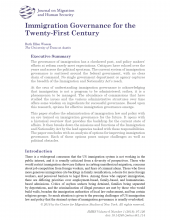Immigration Governance for the Twenty-First Century
Arguing that "immigration is not a program to be administered" but rather "a phenomenon to be managed," Ruth Ellen Wasem, former immigration specialist for the Congressional Research Service and now a Professor of Public Policy at the University of Texas, reviews the "checkered past" of immigration policy over the last century and, despite numerous efforts to reform the system, the "fragmented" and "diffuse" nature of immigration governance today. "Today the US system of immigration governance," she writes, "is scattered across the federal government, with no clear chain of command..."
She discusses the five major functions of immigration governance: selection, border control, enforcement, refugees, and the court system, and the entities with responsibilities in each area. Not only does she describe the current system as "balkanized," but she also laments the fact that "immigration leadership responsibilities are nested at the third tier down within these federal departments and are dispersed across eight agency heads." At the same time, the perspective of other federal agencies, such as agriculture and labor, are not fully integrated into the federal immigration system. She concludes her essay with a number of recommendations, including the formation of an Interagency Council on Immigration and the creation of an Assistant Secretary of immigration in the Department of Homeland Security (DHS) who would oversee all DHS immigration functions. (American Immigrant Policy Portal)
Wasem, R. L. (2018). Immigration Governmance for the Twenty-First Century. Journal of Migration and Human Security, 6(1), 97-120. https://doi.org/10.14240/jmhs.v6i1.114

